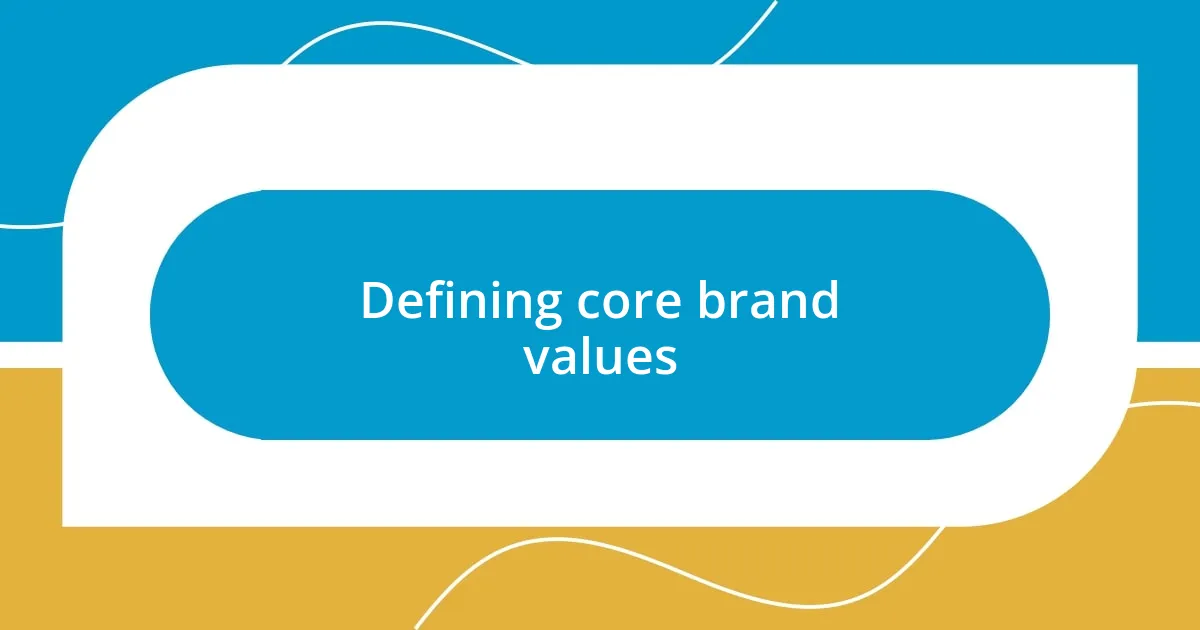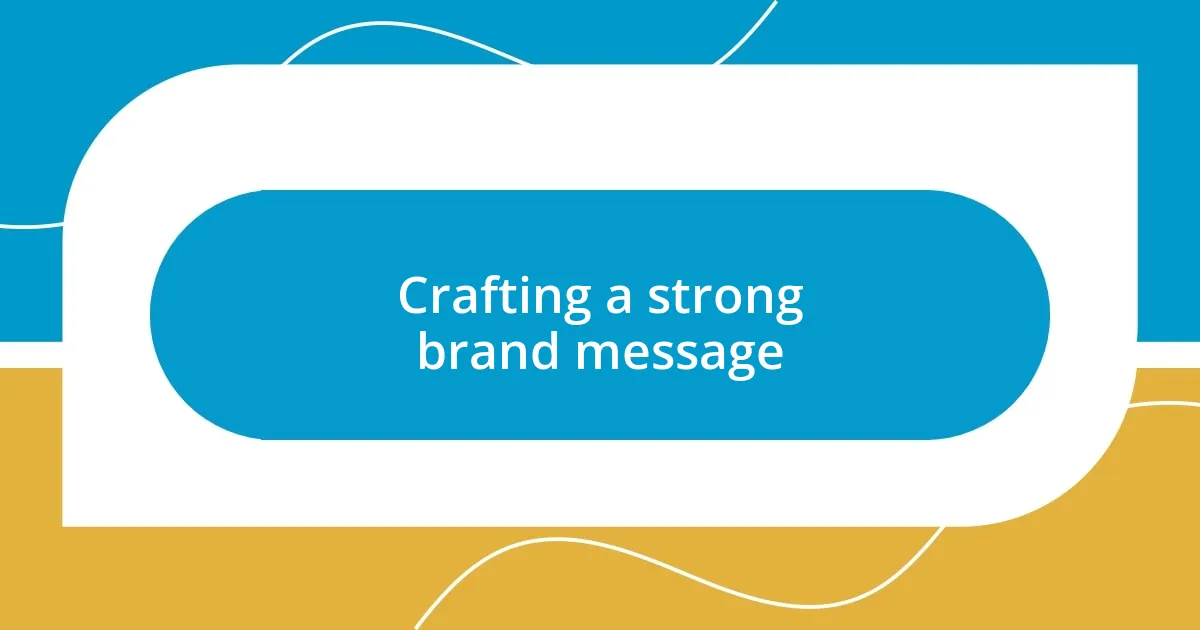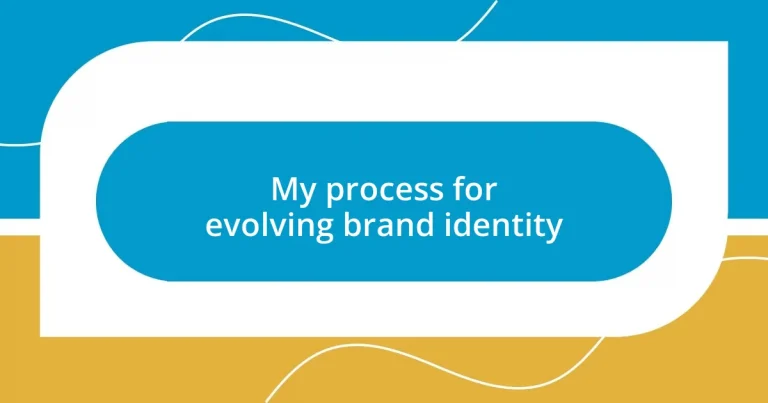Key takeaways:
- Brand identity evolves with market dynamics and consumer perceptions, necessitating regular assessments and feedback to ensure alignment with audience expectations.
- Defining core brand values is essential for authenticity; these values should reflect the true essence of the brand and resonate with the target audience.
- Cohesive visual identity, including consistent use of color, typography, and imagery, enhances brand recognition and builds trust with customers.
- Effective communication and team involvement are critical when implementing brand changes, helping to address emotional ties to existing branding and promote a seamless transition.

Understanding brand identity evolution
Brand identity evolution is a fascinating journey that reflects the changing dynamics of both the market and consumer perceptions. I remember when I first rebranded a small business; the logo was updated, but that wasn’t the whole story. It was about understanding who they were and how they wanted to be seen—which can indeed be challenging.
As your business grows, its identity may need to shift to resonate better with your audience. Have you ever felt a disconnect between how you see your brand and how others perceive it? I experienced this firsthand when I realized that the imagery and messaging we were using didn’t align with our current customer base. This misalignment prompted a deeper exploration into our values and mission, prompting a fresh take on our identity.
It’s essential to recognize that brand identity isn’t a static concept; it evolves alongside social trends and customer expectations. I often find it invigorating to engage with my audience to gather feedback, creating a dialogue that informs the evolution process. It’s remarkable how listening can spark new ideas and lead to a brand identity that feels more authentic and relevant. How has your brand changed over time, and what insights drove that transformation? Your answers could lead to a clearer, more relatable identity that captures the hearts of your audience.

Assessing current brand perception
Assessing current brand perception is a pivotal step in evolving your brand identity. I’ve found that conducting surveys or focus groups can unveil how your audience truly views your brand. For instance, I once gathered feedback from customers about our branding elements, and some insights genuinely surprised me—especially when they associated our image with values we hadn’t intended to communicate.
It’s equally important to analyze your brand presence across different platforms. I remember reviewing our social media channels and website, noticing discrepancies in messaging and visuals. This experience taught me how vital it is for every touchpoint to deliver a consistent narrative that resonates with your target audience. Have you ever thought about how your brand is perceived online versus in person?
Finally, competitor analysis also plays a crucial role. By evaluating how similar brands position themselves, we can identify gaps and opportunities within our own strategy. During a recent survey of our competitors, I noticed common themes in customer engagement strategies that we were missing. This sparked a shift in our approach, ultimately benefiting our brand perception and connection with our audience.
| Method | Description |
|---|---|
| Surveys | Gathering direct feedback from customers to understand their perceptions. |
| Social Media Review | Analyzing the consistency of branding across various platforms. |
| Competitor Analysis | Evaluating similar brands to find gaps in positioning and engagement strategies. |

Defining core brand values
Defining core brand values is the foundation of any successful brand identity. I recall a moment while working with a startup when we faced the question, “What do we stand for?” It wasn’t easy to crystallize our thoughts, but through brainstorming sessions, we unearthed values that resonated deeply with each team member. This process transformed our vision, inspiring not only our branding but also how we communicated our mission to our audience.
When defining core values, consider the following aspects:
– Authenticity: Ensure your values reflect who you truly are, not just what you aspire to be.
– Relevance: Align your values with the needs and expectations of your audience.
– Simplicity: Make your values easy to understand and remember.
– Inspiration: Choose values that motivate both your team and customers to connect with your brand.
– Commitment: Reflect on how these values translate into actions and long-term strategies.
Engaging in this reflective process gave me newfound clarity about our mission—which, in turn, fueled our interactions with customers and partners. It felt like unlocking a treasure chest of purpose that would guide us through every challenge ahead. Have you taken the time to clarify what truly matters to your brand? It’s a worthwhile journey that can invigorate your identity like nothing else.

Identifying target audience and trends
Identifying your target audience is crucial for any brand evolution. I’ve always found that diving into demographic research can reveal not just who your customers are, but what they care about. I remember analyzing patterns from customer purchase history and social media interactions within my own brand; it illuminated preferences I had never considered. Have you taken the time to truly explore what drives your audience’s decisions?
Trends, on the other hand, can feel elusive yet immensely powerful. When I keep my finger on the pulse of industry shifts, I often spot emerging themes that can inform my strategy. For instance, a recent trend toward sustainability motivated me to rethink our sourcing practices. What trends is your industry embracing? If you can anticipate these changes, you can align your brand identity accordingly and stand out in a crowded marketplace.
Balancing audience needs with current trends can sometimes be a tightrope walk, but it is essential for brand growth. I once struggled with this when I faced a choice between catering to our existing loyal customers versus embracing a new, younger demographic drawn in by recent trends. After careful consideration, I opted for a hybrid approach. This not only rejuvenated our brand but also sparked exciting new product lines. How do you strike that balance in your own brand journey?

Developing a cohesive visual identity
Creating a cohesive visual identity is about weaving together elements that tell your brand’s story at a glance. I remember redesigning the logo for a non-profit group I worked with. We started with a jumble of ideas that didn’t feel unified. By narrowing our color palette and selecting typography that echoed our mission, we transformed our scattered visuals into a meaningful representation. Have you ever felt your visual elements just didn’t connect? It’s a game changer when they finally do.
Color, typography, and imagery each play a pivotal role in visual identity. I’ve learned that consistency is key; using the same colors across all platforms cultivates recognition. For example, when I first launched my online store, I used different colors for different products. As a result, customers often felt confused about my brand. Once I settled on a primary palette, sales increased because my visuals became instantly recognizable. Trust me, the right colors matter!
Lastly, incorporating your brand values into your visual identity is essential. I once worked closely with a client who believed in transparency and honesty. We used clear, open designs that reflected this ethos, allowing customers to feel a strong connection to the brand. When clients see a visual identity that reflects authenticity, they’re more likely to engage and trust your brand. How does your visual identity reflect your values? It’s an important reflection point in your brand journey.

Crafting a strong brand message
Crafting a strong brand message is about clarity and resonance. I once faced the challenge of developing a message that truly encapsulated my brand’s essence. It took numerous brainstorming sessions, but boiling down my core values helped me create a tagline that resonated with both my team and customers. Have you ever distilled your brand’s purpose into a simple phrase? It can be transformative.
What I’ve observed is that the best brand messages evoke emotions and foster connections. For example, when I worked on a campaign for a local charity, we centered our messaging around hope and community bonds. I saw firsthand how a heartfelt narrative could turn casual supporters into passionate advocates. How does your brand’s message make people feel? Engaging emotions is key to creating lasting impressions.
Additionally, consistency in messaging across all platforms is vital. I recall a time when my brand shared different messages on social media compared to our website. The result? A confused audience questioning what we stood for. Once we aligned our message, responses improved dramatically—customers felt more connected and informed. Are you providing a cohesive experience through your brand’s message? It’s crucial for loyalty and trust.

Implementing brand identity changes
Implementing brand identity changes can be a delicate dance. I recall a project where we decided to refresh a long-standing brand logo. It wasn’t just about changing visuals; we had to manage the emotions tied to those visuals. It was enlightening to see how some team members clung to the old design, believing it represented their history. How do you navigate sentimental attachments to branding?
Communication is key during implementation. When I revamped my own business identity, I made sure to engage my team in the process. We held discussions and workshops to gather their thoughts and feelings about the new direction. This inclusivity not only eased their concerns but also transformed them into brand ambassadors, passionately sharing the changes with others. Have you considered engaging your team in such a way?
Finally, testing the waters with the new identity before a full rollout can save you from pitfalls. I once launched a revised marketing campaign in a smaller market to gauge reactions. The feedback helped me tweak specific elements that didn’t resonate well, ensuring a smoother transition when we went live on a larger scale. Have you thought about piloting your changes? Sometimes, small adjustments can lead to significant impacts.














